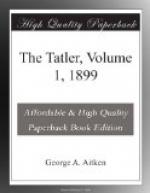Gay’s opinion has been confirmed by the best judges of nearly two centuries, and there is no need to labour the question of the wit and wisdom of the Tatler. But some examples may be cited in illustration of the topics on which Steele and his friends wrote, and the manner in which they dealt with them. The very first numbers contained illustrations of most of what were to be the characteristics of the paper. There is the account of the very pretty gentleman at White’s Chocolate-house thrown into a sad condition by a passing vision of a young lady; the notice of Betterton’s benefit performance; the comments on the war; the campaign against Partridge, with the declaration that all who were good for nothing would be included among the deceased; the discussion on the morality of the stage, with praise of Mrs. Bicknell and reproaches upon a young nobleman who came drunk to the play; the comparison of the rival beauties, Chloe and Clarissa; the satire on the Italian opera, and on Pinkethman’s company of strollers; and the allegorical paper on Faelicia, or Britain. All these and other matters are dealt with in the four numbers which were distributed gratuitously; as the work progressed the principal change, besides the disappearance of the paragraphs of news, was the development of the sustained essay on morals or manners, and the less frequent indulgence in satire upon individual offenders, and in personal allusions in general. This change seems to have been the result partly of design, and partly of circumstances, including Addison’s influence on the work. Steele himself said, as we have seen, that the Tatler was raised to a greater height than he had designed; but no doubt he realised that he must feel his way, and be at first a tatler rather than a preacher. After some grave remarks about duelling in an early paper (No. 26), he makes Pacolet, Bickerstaff’s familiar, say, “It was too soon to give my discourse on this subject so serious a turn; you have chiefly to do with that part of mankind which must be led into reflection by degrees, and you must treat this custom with humour and raillery to get an audience, before you come to pronounce sentence upon it.”
Follies and weaknesses are ridiculed in the Tatler in a genial spirit, by one who was fully alive to his own imperfections, and point is usually given to the papers by a sketch of some veiled or imaginary individual. In this way Bickerstaff treats of fops,[15] of wags,[16] of coquettes,[17] of the lady who condemned the vice of the age, meaning the only vice of which she was not guilty;[18] of impudence;[19] and of pride and vanity.[20] In a graver tone he attacks the practice of duelling;[21] gamesters and sharpers;[22] drunken “roarers” and “scowrers";[23] and brutal pastimes at the Bear Garden and elsewhere.[24] The campaign against swindlers exposed Steele to serious threats on more than one occasion.[25]




